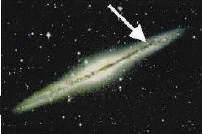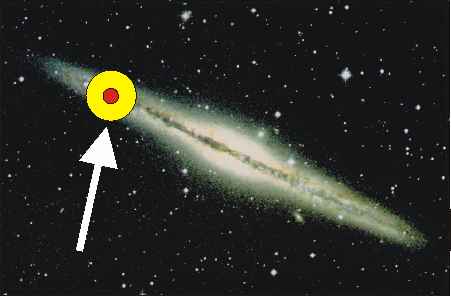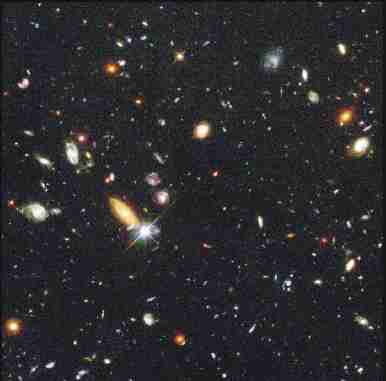






| Website Stats |
Visits from over |
|
Free downloads |
You can now read the material from this website on most electronic devices: -On your computer
Two NEW books from the author of BibleHelp
|
What an Awesome God
Back
You are here

I’ve provided this map in case you get lost
Chapter: 11.04
(Section 11: Understanding God and His Universe)
Copyright © Michael Bronson 1997, 1999, and 2000
BibleHelp.org
Summary
If you want to learn more about our creator, take a look at His creation. I think you may be surprised and awed when you take a closer look at His incredible universe.
Click Here for a book version of this material
Zaphod Beeblebrox was filled with apprehension as he was escorted to the Frog Star’s Total Perspective Vortex. As he drew closer to the dreaded machine, he could hear the screams escaping from its victims. Zaphod Beeblebrox knew that one second in this savage torture device would turn his mind to mush.
Originally, the Total Perspective Vortex was not created as a tool of torture and punishment; it was designed as an educational tool. There was an inventor who would spend hours at a time staring at the stars contemplating the immense size of the universe. His wife, however, didn’t understand or appreciate his work. She would continually nag him to spend his time on the more important things. "Have a sense of proportion and perspective," she would say. So, he built the Total Perspective Vortex to give her a sense of perspective. He wanted her to see why he was spending so much time studying the universe.
The Total Perspective Vortex gives a person a complete glimpse of the whole universe almost instantaneously. It compares the incredibly small size of the person to the enormous size of the universe. It shows him the size of the "entire unimaginable infinity of creation" along with a tiny little marker that says, "You are here."
When the inventor connected his wife to the Total Perspective Vortex, she saw, in an instant, the whole infinity of creation and herself in relation to it. The shock of this discovery totally annihilated her brain. Although this psychotic break was totally unexpected and undesired, it did stop her from nagging. When the evil inhabitance of Frog Star heard about this invention, they immediately saw its potential as a torture device.
To everyone's surprise and amazement, Zaphod Beeblebrox exited the Total Perspective Vortex totally unscathed. It didn’t affect him at all (except for being a little thirsty). He became the first and only person to survive the Total Perspective Vortex.
The reason for Zaphod Beeblebrox’s survival was actually quite simple; he had a large ego. In fact, his ego was so large it was the size of the universe. He actually thought he was the most important person in the universe. As a result, he didn’t see himself as being insignificant in comparison to the gigantic universe. The immense size of the universe didn’t overwhelm him or make him feel hopelessly lost.
This story, of course, was taken from the classic novel The Hitchhiker’s Guide to the Galaxy. If you have ever wondered about life, the universe, and whatever, you can find the answer in this book. (In case you are wondering, the book says that the answer to "life, the universe, and whatever" is 42).
If you like dry British humor, you’ll love The Hitchhiker’s Guide to the Galaxy. Although the Total Perspective Vortex is not real, the fear that something like this could cause is real. Seeing oneself in relationship to the immense universe can be frightening. In fact, before my mom became a Christian, this very thing frightened her.
A couple years after my parents were married, my dad told my mom about the enormous size of the universe. This began to scare her. It made her feel small, insignificant, and inadequate. This led her to feel isolated, vulnerable, and overwhelmed.
It was one thing to view herself as a small insignificant dot on planet Earth, but it was devastating to discover that our incredibly large galaxy (Milky Way) was only a small insignificant dot in a gigantic universe. It was hard enough visualizing a higher power being able to keep a personal eye on every single person on planet Earth, but it seemed inconceivable that personal attention could be given to each person with a universe this large. This made her feel like her life had no meaning and purpose; that there was no watchful eye looking out for her protection.
We usually think of the stars as being loosely scattered throughout the vast expanse of outer space. As you can see from the picture at the beginning of the chapter, these stars are not "spread out," but are "lumped" together in confined groups called galaxies. These confined groups, however, are still enormous in size. Our galaxy (the Milky Way), for example, is over 90,000 light years wide. This means if you were traveling at the speed of light (186,282 miles per second) it would take you 90,000 years to get from side to side. For you joggers, that’s a distance of over 500 million billion miles. Although our galaxy is incredibly huge, it is only a small spec in comparison to the rest of the universe. There are at least a 100 billion galaxies in the universe.
Most galaxies consist of 10 to 100 billion suns (stars). Our Milky Way, however, has around 200 to 400 billion stars and there are some galaxies that have over 50 trillion stars. When we look up at night and see the stars scattered throughout the sky, we usually think we are seeing the various stars scattered throughout the whole universe. In reality, though, we are only seeing the stars in our own galaxy; and even then it is only a small portion of them (about 3,000 stars).

|
The galaxy above is similar to our Milky Way. The red circle shows the basic range of most of our nighttime vision. The yellow circle shows the location of some of the very bright stars we see at night. As you can see, we can see only a small portion of our own galaxy. There are hundreds of billions of other galaxies outside our normal field of vision. |
Although 100 billion galaxies take up a lot of room, the empty space between the galaxies is even larger. If a space explorer had the ability to instantly and randomly transport himself to anyplace in the universe, he would find himself in empty dark space over 99% of the time. Even the "closest" stars or galaxies would still be too far away for him to see.1
 |
The chart above shows the vast emptiness of outer space. These few galaxies are the only ones in this entire region. Item 1 shows where we live (the Milky Way) and item 2 shows our nearest galaxy (Large Magellanic Cloud). If a space traveler could travel at the speed of light, it would still take him 170,000 years to reach our nearest galaxy. It would take him 2.3 million years to reach our closest major galaxy (item 3). Note the vast empty space between our galaxy and item 3. (To get a more accurate map showing the names and locations of our closest galaxies, go to http://en.wikipedia.org/wiki/Local_Group).
Go back to the photograph on the first page (the one that shows the limited range of our nighttime vision). Now go to the chart (above) showing the locations of our closest galaxies. Our nighttime vision on that chart would be smaller than the period (.) on this page. That explains why a space traveler would find total darkness 99% of the time.
The powerful Hubble telescope was pointed to a "dark" spot near the Big Dipper and took the photograph below. This deep field photograph captured previously unknown galaxies residing deep in the universe. No other telescopes has the power to be able to see galaxies this far away. These galaxies are so far away, it took 100 hours of exposure time to take this picture.

Photo by NASA 1995, Hubble telescope
Although the Hubble telescope is very powerful, it still cannot see the "far edges" of the universe. We have no idea of what’s behind the galaxies in this photo. What would we see if we had a more powerful telescope? I believe if we were to point it to a "dark spot" between a couple of these galaxies, we would probably come up with a photograph full of newly discovered galaxies.
Nearly every object in this photograph is a galaxy with hundreds of billions of suns. (The poster version of this photograph shows many more galaxies than this low resolution Internet photograph.) Considering the tremendous size of a single galaxy, this photograph represents a very large expanse. Take a few moments to reflect on this.
The thing that makes this random photograph so spectacular is the fact that it is a very, very small sample of our universe. Go outdoors some night and stretch out your arm and pretend you are holding a grain of sand between your fingers. That distance between your fingers is the amount of area from which this photograph was taken.
If scientists didn’t already have enough to think about, God has given them another problem to ponder. It appears there is more to the universe than what meets the eye. Calculations have shown that there is an unknown invisible mass scattered throughout the universe (usually near clusters of galaxies). This mysterious mass (referred to as "dark matter") is exerting a tremendous gravitational pull on the galaxies.
This dark matter is different from the "black holes" astronomers have been recently talking about. I won’t go into the complex details to describe this mysterious mass, but scientists feel that the "invisible" part of the universe may be 10 to 100 times the mass of the visible universe. So, if you thought the universe was already incredibly large, try thinking of it being 10 to 100 times larger.
Yes, our universe is very large, but there is still more to it than what you probably realize. Most people have never considered the amount of energy needed to create a single atom. Powerful bonds hold atoms together and when these bonds are broken, a tremendous amount of energy is released. This energy can be calculated by using Albert Einstein’s historic E=mc2 (See footnote #2 below for more information).
For example, the atomic energy stored in 1 gram (.035 ounce) of matter is equal to the power obtained from 700,000 gallons of octane fuel. (Source: ChemCom, page 309.) For a more dramatic example, the atomic energy stored in the atoms of a 200-pound man is equal to 157,307 atomic bombs (the ones dropped on Hiroshima). For you weightlifters, that's the same as bench-pressing a 500-pound weight over 12 million billion times.
If there is that much atomic energy in a 200-pound man, imagine how much energy was needed to create the whole universe. Imagine the magnitude of the God who created all this. I find it amazing that people actually have the audacity to say that they will boldly stand up to God when they enter eternity. They obviously don’t comprehend the God who created them.
Just as our minds can’t comprehend the magnitude and complexity of the universe, it can’t comprehend the magnitude and complexity of God. Obviously, God is far greater and more powerful than the universe He created. Even though our universe is incredibly staggering in size, it is probably just a minuscule dot in comparison to God’s actual greatness and power. I can’t even begin to imagine how great, majestic, powerful, and awesome our God must be.
Psalms 8:3 says, "When I consider your heavens, the work of your fingers ..." Although we should be careful about reading too much into a single verse, it almost sounds like the Bible is saying that it was a simple thing for God to create the universe. It kind of sounds like our phrase, "He barely needed to raise a finger to get the job done."
The reason I’m writing this chapter is because we all (including myself) take God for granted. We would never talk to or treat a powerful earthly king the way we do God. Most of us do not praise or honor God the way we should. If we truly saw God for who and what He is, we would immediately fall prostrate before Him. There would be no question at all that He is Lord of lords and King of kings. The song Our God is an Awesome God would flow naturally from our lips. Worshiping and praising God would be a privilege and pleasure.
Obviously, God is an incredible being. The thing I find even more amazing is the fact that He has taken a personal interest in our lives and has invited us to be His friend. In fact, He has actually invited us to marry Him3. Think about that: Being married to God Almighty. Most of us would be greatly honored if we were invited to be guests at a royal wedding in England, yet we often yawn at our upcoming marriage to God Almighty.
Take a vacation from your hectic schedule and go outdoors to a quiet place. Spend some time thinking about the creator of our universe. Take a trip through the Total Perspective Vortex and see yourself in relation to this gigantic universe. When you see the tiny little sign that says, "You are here," be sure to look at the bottom of the sign. It says, "You are very important to me -God."
Footnote 1
Most of the universe (99%) is void of any stars or galaxies and is, therefore, totally dark. There are, however, some very bright galaxies (as bright as 50 trillion stars). As a result, these "totally dark" areas of space might have a very faint, single white dot.
Footnote 2
Einstein’s historic formula, E=mc2 provides us a way to calculate the atomic energy of an object (multiply the mass of the object by the speed of light squared). The formula to find the atomic energy of a 200 pound (90.9 kg) man would look like this:
Energy = (90.9) x (3 x 108)2
Therefore, the atomic energy in a 200-pound man is 8.18 x 1018 joules. The bomb dropped on Hiroshima released 5.2 x 1013 joules of energy (the same destructive power of 13,000 tons of TNT). This means that the atomic energy in a 200 pound man is 157,307 times greater than the Hiroshima bomb.
Most people don’t realize it, but very little of the uranium’s atomic energy was actually released over Hiroshima. First, it is estimated that only one pound of the 15 pounds of uranium was able to reach critical mass and split. Second, only an incredibly small number of atomic bonds were even intended to be broken. Many people think that the atomic explosion was the result of the uranium breaking down completely. In reality, though, the uranium atoms only split in half (making Barium-140 and Krypton-93). Basically, all of the other bonds remained intact. If all of the bonds in the uranium’s atoms were broken, the energy released would have been over 16,000 times greater.
Calculation of the bench presses: One joule is equal to .737 foot-pound. Therefore, the 8.18 x 1018 joules of atomic energy found in a 200 pound man is equal to 6.033 x1018 foot-pounds. The 6.033 x1018 foot-pounds is 6,033,000,000,000,000,000 pounds of weight being lifted one foot. A single bench-press of a one-pound weight is approximately equal to one "foot-pound" of energy. Therefore, this energy is equal to a person lifting 500 pounds over 12 million billion times.
Footnote 3
Verses that talk about us marrying God Almighty: Revelations. 19:7,9; 21:2,9, Ephesians 5:32, Is. 54:5,6; 62:4-5, Hos. 2:16,19, Matthew. 22:2-14.
Related Sources:
The Universe and Beyond, (1999) by Terence Dickinson
Endless Universe, (1999) by Heather Couper
Other Worlds, (1999) by James Trefil
Majestic Universe, (1999) by Serge Brunier
Nightwatch, (2000), by Herence Dickinson
Atlas of Deep-sky splendors, (1983) by Hans Vehrenberg
Other Chapters in this Section
Home
Tell a Friend about this page

